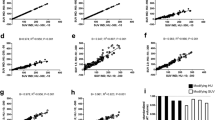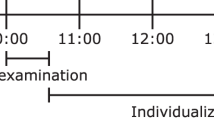Abstract
Objectives
It has been reported that the prevalence of 18F fluorodeoxyglucose (FDG) uptake in brown adipose tissue (BAT) is related to outdoor temperature, i.e., more frequent during the colder periods of the year. The purpose of this study was to assess the temporal relationship between BAT FDG uptake and temperature. We correlated the prevalence of BAT with average temperatures (divided into five temperature ranges) of seven different durations.
Methods
One thousand four hundred ninety-five consecutive FDG Positron emission tomography (PET) studies in 1,159 patients (566 male and 593 female, mean age = 60.4 years) were retrospectively reviewed. FDG uptake with distinct patterns compatible with BAT was identified by a consensus of two readers. The local daily average temperature from January 2000 to November 2003 (beginning 60 days before the date of first PET scan) were obtained, and 2-, 3-, 7-, 14-, 30-, and 60-day average temperatures before the date of a PET study were calculated. The prevalence of BAT FDG uptake was correlated with these various average temperatures.
Results
The daily, 2-day, 3-day, and 7-day average temperature had an inverse relation with the prevalence of BAT, i.e., the lower the temperature, the higher prevalence of BAT. When the temperature was averaged over 14 days or longer, this inverse relationship between the temperature and the prevalence of BAT was no longer preserved.
Conclusions
Our data suggest that increased FDG uptake in BAT occurs more often as an acute response to cold weather (1-7 days) rather than to prolonged periods of average cold weather.


Similar content being viewed by others
References
Cohade C, Osman M, Pannu HK, Wahl RL. Uptake in supraclavicular area fat (“USA-Fat”): description on 18F-FDG PET/CT. J Nucl Med 2003;44:170-6.
Hany TF, Gharehpapagh E, Kamel EM, Buck A, Himms-Hagen J, von Schulthess GK. Brown adipose tissue: a factor to consider in symmetrical tracer uptake in the neck and upper chest region. Eur J Nucl Med Mol Imaging 2002;29:1393-8.
Cohade C, Mourtzikos K, Wahl R. “USA-Fat”: prevalence is related to ambient outdoor temperature—evaluation with 18F-FDG PET/CT. J Nucl Med 2003;44:1267-70.
Moura MA, Kawashita NH, Brito SM, Brito MN, Kettelhut IC, Migliorini RH. Effect of cold acclimation on brown adipose tissue fatty acid synthesis in rats adapted to a high-protein, carbohydrate-free diet. Metabolism 2001;50:1493-8.
Yeung H, Grewal R, Gonen M, Schöder H, Larson S. Patterns of 18F-FDG Uptake in adipose tissue and muscle: a potential source of false-positives for PET. J Nucl Med 2003;44:1789-96.
Cannon B, Nedergaard J. Brown adipose tissue: function and physiological significance. Physiol Rev 2004;84:277-359.
Greco-Perotto R, Zaninetti D, Assimacopoulos-Jeannet F, Bobbioni E, Jeanrenaud B. Stimulatory effect of cold adaptation on glucose utilization by brown adipose tissue: relationship with changes in the glucose transporter system. J Biol Chem 1987;262:7732-6.
Olichon-Berthe C, Van Obberghen E, Le Marchand-Brustel Y. Effect of cold acclimation on the expression of glucose transporter Glut 4. Mol Cell Endocrinol 1992;89:11-8.
Ploug T, Ralston E. Exploring the whereabouts of GLUT4 in skeletal muscle. Mol Membr Biol 2002;19:39-49.
Konrad D, Bilan P, Nawaz Z, Sweeney G, Niu W, Liu Z, et al. Need for GLUT4 activation to reach maximum effect of insulin-mediated glucose uptake in brown adipocytes isolated from GLUT4myc-expressing mice. Diabetes 2002;51:2719-26.
Kawashita NH, Brito MN, Brito SR, Moura MA, Festuccia WT, Garofalo MA, et al. Glucose uptake, glucose transporter GLUT4, and glycolytic enzymes in brown adipose tissue from rats adapted to a high protein diet. Metabolism 2002;51:1501-1505.
Shibata H, Perusse F, Vallerand A, Bukowiecki LJ. Cold exposure reverses inhibitory effects of fasting on peripheral glucose uptake in rats. Am J Physiol Regul Integr Comp Physiol 1989;257:R96-R101.
Ebner S, Burnol A, Ferre P, de Saintaurin M, Girard J. Effects of insulin and norepinephrine on glucose transport and metabolism in rat brown adipocytes. Eur J Biochem 1987;170:469-74.
Liu X, Perusse F, Bukowiecki LJ. Mechanisms of the antidiabetic effects of the beta 3-adrenergic agonist CL-316243 in obese Zucker-ZDF rats. Am J Physiol Regul Integr Comp Physiol 1998;274:R1212-9.
Marette A, Bukowiecki LJ. Noradrenaline stimulates glucose transport in rat brown adipocytes by activating thermogenesis. Evidence that fatty acid activation of mitochondrial respiration enhances glucose transport. Biochem J 1991;277:119-24.
Marette A, Bukowiecki LJ. Stimulation of glucose transport by insulin and norepinephrine in isolated rat brown adipocytes. Am J Physiol Cell Physiol 1989;257:C714-21.
Omatsu-Kanbe M, Kitasato H. Insulin and noradrenaline independently stimulate the translocation of glucose transporters from intracellular stores to the plasma membrane in mouse brown adipocytes. FEBS Lett 1992;314:246-50.
Shimizu Y, Nikami H, Tsukazaki K, Machado UF, Yano H, Seino Y, et al. Increased expression of glucose transporter GLUT-4 in brown adipose tissue of fasted rats after cold exposure. Am J Physiol Endocrinol Metab 1993;264:E890-5.
Le Marchand-Brustel Y, Olichon-Berthe C, Gremeaux T, Tanti JF, Rochet N, Van Obberghen E. Glucose transporter in insulin sensitive tissues of lean and obese mice. Effect of the thermogenic agent BRL 26830A. Endocrinology 1990;127:2687-95.
Santalucia T, Camps M, Castello A, Munoz P, Nuel A, Testar X, et al. Developmental regulation of GLUT-1 (erythroid/Hep G2) and GLUT-4 (muscle/fat) glucose transporter expression in rat heart, skeletal muscle, and brown adipose tissue. Endocrinology 1992;130:837-46.
Shimizu Y, Kielar D, Minokoshi Y, Shimazu T. Noradrenaline increases glucose transport into brown adipocytes in culture by a mechanism different from that of insulin. Biochem J 1996;314:485-90.
Shimizu Y, Satoh S, Yano H, Minokoshi Y, Cushman SW, Shimazu T. Effects of noradrenaline on the cell-surface glucose transporters in cultured brown adipocytes: novel mechanism for selective activation of GLUT1 glucose transporters. Biochem J 1998;330:397-403.
Garcia CA, Van Nostrand D, Atkins F, Acio E, Butler C, Esposito G, et al. Reduction of brown fat 2-deoxy-2-(F-18)fluoro-D-glucose uptake by controlling environmental temperature prior to positron emission tomography scan. Mol Imaging Biol 2006;8:24-9.
Nedergaard J. Effects of cations on brown adipose tissue in relation to possible metabolic consequences of membrane depolarisation. Eur J Biochem 1981;114:159-67.
Svartengren J, Svoboda P, Cannon B. Desensitisation of β-adrenergic responsiveness in-vivo. Decreased coupling between receptors and adenylate cyclase in isolated brown fat cells. Eur J Biochem 1982;128:481-8.
Unelius L, Bronnikov G, Mohell N, Nedergaard J. Physiological desensitization of β3 adrenergic responsiveness in brown fat cells. Involvement of a post-receptor mechanism. Am J Physiol Cell Physiol 1993;265:C1340-8.
Leppaluoto J, Korhonen I, Hassi J. Habituation of thermal sensations, skin temperatures, and norepinephrine in men exposed to cold air. J Appl Physiol 2001;90:1211-8.
Author information
Authors and Affiliations
Corresponding author
Rights and permissions
About this article
Cite this article
Kim, S., Krynyckyi, B.R., Machac, J. et al. Temporal relation between temperature change and FDG uptake in brown adipose tissue. Eur J Nucl Med Mol Imaging 35, 984–989 (2008). https://doi.org/10.1007/s00259-007-0670-4
Received:
Accepted:
Published:
Issue Date:
DOI: https://doi.org/10.1007/s00259-007-0670-4




